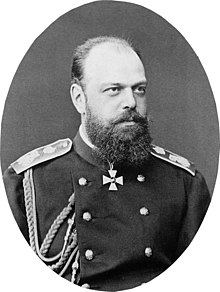Emperor Alexander III
| Alexander III | |||||
|---|---|---|---|---|---|
 |
|||||
| Reign | 13 March 1881 – 1 November 1894 | ||||
| Coronation | 27 May 1883 | ||||
| Predecessor | Alexander II | ||||
| Successor | Nicholas II | ||||
| Born |
10 March 1845 Winter Palace, Saint Petersburg, Russian Empire |
||||
| Died | 1 November 1894 (aged 49) Maley Palace, Livadia, Taurida Governorate, Russian Empire |
||||
| Burial | Peter and Paul Cathedral, Saint Petersburg, Russian Empire | ||||
| Spouse | Maria Feodorovna (Dagmar of Denmark) | ||||
| Issue Detail |
Nicholas II of Russia Grand Duke Alexander Alexandrovich Grand Duke George Alexandrovich Grand Duchess Xenia Alexandrovna Grand Duke Michael Alexandrovich Grand Duchess Olga Alexandrovna |
||||
|
|||||
| House | Holstein-Gottorp-Romanov | ||||
| Father | Alexander II of Russia | ||||
| Mother | Maria Alexandrovna (Marie of Hesse) | ||||
| Religion | Russian Orthodox | ||||
| Signature |  |
||||
| Full name | |
|---|---|
| Alexander Alexandrovich Romanov |
|
Styles of Alexander III of Russia |
|
|---|---|
 |
|
| Reference style | His Imperial Majesty |
| Spoken style | Your Imperial Majesty |
| Alternative style | Sir |
Alexander III (Russian: Алекса́ндр III Алекса́ндрович, tr. Aleksandr III Aleksandrovich; 10 March [O.S. 26 February] 1845 – 1 November [O.S. 20 October] 1894) was the Emperor of Russia, King of Poland, and Grand Duke of Finland from 13 March [O.S. 1 March] 1881 until his death on 1 November [O.S. 20 October] 1894. He was highly conservative and reversed some of the liberal reforms of his father, Alexander II. During Alexander's reign Russia fought no major wars, for which he was styled "The Peacemaker" (Russian: Миротво́рец, Mirotvórets, IPA: [mʲɪrɐˈtvorʲɪt͡s]).
Grand Duke Alexander Alexandrovich was born on 10 March 1845 at the Winter Palace in Saint Petersburg, Russian Empire, the second son and third child of Emperor Alexander II of Russia and his first wife Marie of Hesse.
In disposition Alexander bore little resemblance to his soft-hearted, liberal father, and still less to his refined, philosophic, sentimental, chivalrous, yet cunning great-uncle, Emperor Alexander I of Russia, who could have been given the title of "the first gentleman of Europe". Although an enthusiastic amateur musician and patron of the ballet, Alexander was seen as lacking refinement and elegance. Indeed, he rather relished the idea of being of the same rough texture as some of his subjects. His straightforward, abrupt manner savoured sometimes of gruffness, while his direct, unadorned method of expressing himself harmonized well with his rough-hewn, immobile features and somewhat sluggish movements. His education was not such as to soften these peculiarities. More than six feet tall (about 1.9 m), he was also noted for his immense physical strength. A sebaceous cyst on the left side of his nose caused him to be mocked by some of his contemporaries, and he sat for photographs and portraits with the right side of his face most prominent.
...
Wikipedia
